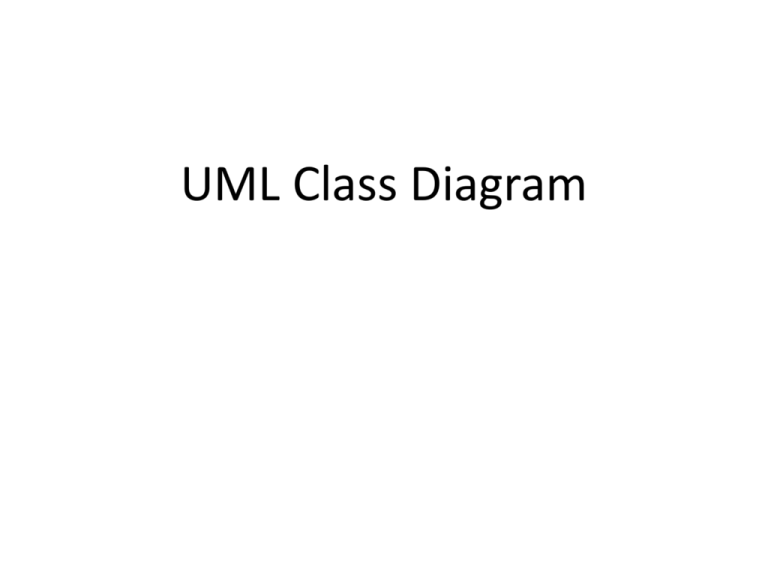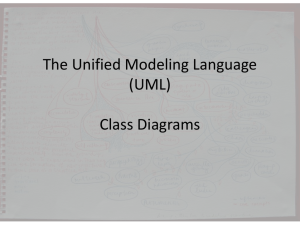UML Class Diagram
advertisement

UML Class Diagram
Agenda
• What is a Class Diagram?
• Essential Elements of a UML Class Diagram
• Tips
UML Class Diagrams
2
What is a Class Diagram?
• A Class Diagram is a diagram describing the
structure of a system
• shows the system's
•
•
•
•
classes
Attributes
operations (or methods),
Relationships among the classes.
UML Class Diagrams
3
Essential Elements of a UML Class
Diagram
•
•
•
•
Class
Attributes
Operations
Relationships
–
–
–
–
Associations
Generalization
Realization
Dependency
• Constraint Rules and Notes
UML Class Diagrams
4
Class
• Describes a set of objects having similar:
– Attributes (status)
– Operations (behavior)
– Relationships with other classes
• Attributes and operations may
–
–
–
–
–
have their visibility marked:
"+" for public
"#" for protected
"−" for private
"~" for package
UML Class Diagrams
Class Name
Window
Attributes
size: Size
visibility: boolean
Operations
display()
hide()
5
Associations
• An association between two classes indicates that
objects at one end of an association “recognize”
objects at the other end and may send messages
to them.
• Example: “An Employee works for a Company”
Employee
Company
UML Class Diagrams
6
Associations (cont.)
Role
name
StaffMember
instructor
1..*
Multiplicity
Association
name
instructs
*
Navigable
(uni-directional)
association
Student
Role
*
Courses
Reflexive
association
UML Class Diagrams
pre requisites
0..3
7
Associations (cont.)
• To clarify its meaning, an association may be named.
– The name is represented as a label placed midway along
the association line.
– Usually a verb or a verb phrase.
• A role is an end of an association where it connects
to a class.
– May be named to indicate the role played by the class
attached to the end of the association path.
• Usually a noun or noun phrase
• Mandatory for reflexive associations
UML Class Diagrams
8
Associations (cont.)
• Multiplicity
– the number of objects that participate in the association.
– Indicates whether or not an association is mandatory.
Multiplicity Indicators
Exactly one
1
Zero or more (unlimited)
* (0..*)
One or more
1..*
Zero or one (optional association)
0..1
Specified range
2..4
Multiple, disjoint ranges
UML Class Diagrams
2, 4..6, 8
9
Aggregation
• A special form of association that models a
whole-part relationship between an
aggregate (the whole) and its parts.
– Models a “is a part-part of” relationship.
2..*
Car
Whole
Door
1..*
House
Part
UML Class Diagrams
10
Aggregation (cont.)
• Aggregation tests:
– Is the phrase “part of” used to describe the relationship?
• A door is “part of” a car
– Are some operations on the whole automatically applied to its
parts?
• Move the car, move the door.
– Are some attribute values propagated from the whole to all or
some of its parts?
• The car is blue, therefore the door is blue.
– Is there an intrinsic asymmetry to the relationship where one
class is subordinate to the other?
• A door is part of a car. A car is not part of a door.
UML Class Diagrams
11
Composition
• A strong form of aggregation
– The whole is the sole owner of its part.
• The part object may belong to only one whole
– Multiplicity on the whole side must be zero or one.
– The life time of the part is dependent upon the whole.
• The composite must manage the creation and destruction of
its parts.
Circle
Polygon
1
Point
3..*
UML Class Diagrams
Circle
Point
12
• Aggregation (shared aggregation):
• is a specialized form of ASSOCIATION in which a whole
is related to its part(s).
• is known as a “part of” or containment relationship and
follows the “has a” heuristic
• three ways to think about aggregations:
• whole-parts
• container-contents
• group-members
• Composition (composite aggregation):
• is a stronger version of AGGREGATION
• the “part(s)” may belong to only ONE whole
• the part(s) are usually expected to “live” and “die” with
the whole (“cascading delete”)
Generalization
• Indicates that objects of the specialized
class (subclass) are substitutable for objects
of the generalized class (super-class).
– “is kind of” relationship.
{abstract} is a
tagged value that
indicates that the
class is abstract.
The name of an
abstract class should
be italicized
An abstract
class
Shape
{abstract}
Super
Class
Generalization
relationship
Circle
UML Class Diagrams
Sub Class
14
Generalization
• A sub-class inherits from its super-class
– Attributes
– Operations
– Relationships
• A sub-class may
– Add attributes and operations
– Add relationships
– Refine (override) inherited operations
• A generalization relationship may not be used to
model interface implementation.
UML Class Diagrams
15
Realization
• A realization relationship indicates that one
class implements a behavior specified by
another class (an interface or protocol).
• An interface can be realized by many
classes.
• A class may realize many interfaces.
LinkedList
<<interface>>
List
UML Class Diagrams
ArrayList
16
Dependency
• Dependency is a weaker form of relationship which indicates
that one class depends on another because it uses it at some
point in time.
• One class depends on another if the independent class is a
parameter variable or local variable of a method of the
dependent class.
• This is different from an association, where an attribute of the
dependent class is an instance of the independent class.
Iterator
<<friend>>
UML Class Diagrams
Vector
17
Constraint Rules and Notes
• Constraints and notes annotate among other
things associations, attributes, operations and
classes.
• Constraints are semantic restrictions noted as
Boolean expressions.
– UML offers many pre-defined constraints.
Customer
id: long { value > 0 }
1
*
{ total < $50 }
Constraint
Order
may be
canceled
Note
UML Class Diagrams
18
Traffic Violation Report System Example
TrafficPoliceman 1 issues *
TrafficReport
id : long
description : String
occuredAt : Date
Offender
1..*
1
name : String
id : long
reports of
1..*
Policeman
id : long
name : String
rank : int
Violation
id : long
description : String
<<abstract>>
UML Class Diagrams
19
Analysis Classes Elicitation
• Consider main perspectives of the system
• Interface between the system and its actors
– Protocols for information exchange
– Don’t concentrate on visual aspects
• Data the system uses
– The core of the system, key concepts
• The system logic
– Controls and coordinates the behavior
– Delegates the work to other classes
– Decouples interface and data classes
UML Class Diagrams
20
Tips
• Don’t try to use all the various notations.
• Don’t draw models for everything,
concentrate on the key areas.
UML Class Diagrams
22
Analysis Classes
• A technique for finding analysis classes which
uses three different perspectives of the
system:
• The boundary between the system and its actors
(Boundary)
• The information the system uses (Entity)
• The control logic of the system (Control)
UML Class Diagrams
23
Boundary Classes
• Models the interaction between the system’s
surroundings and its inner workings
– User interface classes
• Concentrate on what information is presented to the
user
• Don’t concentrate on user interface details
– System / Device interface classes
• Concentrate on what protocols must be defined. Don’t
concentrate on how the protocols are implemented
UML Class Diagrams
24




